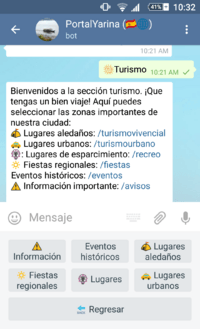Chatterbot facts for kids

A chatbot is a special computer program that can have conversations with people. It talks using text, like in a chat, or sometimes even with sounds. Chatbots are made to sound like a real person talking, so much so that sometimes you might not even know you're talking to a computer!
These programs are often used to help customers or to find information. Some chatbots use very smart systems to understand what you say, like natural language processing. But many simpler ones just look for certain words you use. Then, they pick the best answer from a list they already have.
The word "ChatterBot" was first used in 1994 by Michael Mauldin. Today, chatbots are a big part of virtual assistants like Google Assistant. You can find them on many apps, websites, and chat programs like Facebook Messenger. Besides helping with tasks, some chatbots are just for fun, for research, or to share information about a product or idea.
Contents
How Chatbots Started
In 1950, a famous scientist named Alan Turing wrote about a test called the Turing test. This test helps us see if a computer program can act like a human. In the test, a person chats with both a computer and a real human. If the person can't tell which is the computer, then the computer passes the test!
This idea made people very interested in a program called ELIZA, which came out in 1966. ELIZA seemed to trick people into thinking they were talking to a real person. But its creator, Joseph Weizenbaum, said ELIZA wasn't truly smart. He explained that ELIZA just used simple tricks.
ELIZA's main trick was to look for certain words or phrases you typed. Then, it would give a pre-written answer that seemed to make sense. For example, if you typed something with the word 'MOTHER', ELIZA might reply, 'TELL ME MORE ABOUT YOUR FAMILY'. This made it seem like ELIZA understood you, even though it was just following simple rules. It showed how easy it is to make people think a computer is smart, even when it's not really "thinking."
How Chatbots Grew
Some of the first famous chatbots were ELIZA (from 1966) and PARRY (from 1972). Later on, other important programs like A.L.I.C.E. and Jabberwacky were created. While ELIZA and PARRY only chatted by typing, many newer chatbots can also play games or help you search the web.
A big part of making smart chatbots is called natural language processing. This is a field of AI that helps computers understand human language. Many chatbots use special computer languages. For example, A.L.I.C.E. uses a language called AIML. This language helps it match patterns in what you say to give a reply. However, A.L.I.C.E. mostly uses the same simple "pattern matching" trick that ELIZA used a long time ago. It doesn't really "reason" or "think" like a human.
Some chatbots, like Jabberwacky, can actually learn new answers and ideas from talking to people in real time. They don't just use a fixed list of answers. Other advanced chatbots even use evolutionary algorithms to get better at talking with each conversation they have. But even with these advances, there isn't a general-purpose chatbot that can talk about anything like a human can. Many developers focus on making chatbots good at finding specific information.
There are even competitions for chatbots, like the Loebner Prize. These contests often test how well a chatbot can pass the Turing test.
How Chatbots Are Used Today
Chatbots are often built into dialog systems, which are programs that help people talk to computers. For example, virtual assistants use chatbots to have casual chats or answer simple questions that aren't part of their main job.
On Messaging Apps

Today, chatbots are very popular on chat apps like Facebook Messenger, WeChat, and Kik. They are used for fun, for businesses to talk to customers, and for customer service. These bots usually appear as one of your contacts or in a group chat.
Some chat bots can connect to outside information. They can give you news, weather reports, directions, movie times, or stock prices. Big companies like Domino's, Pizza Hut, and Whole Foods use chatbots. They help customers order easily, promote products, and keep customers interested. In the travel world, airlines like Aeroméxico and KLM use chatbots on Messenger. You can buy tickets, check flight status, get boarding passes, and even find hotels or restaurants.
On Websites and Apps
Before, many companies had chatbots on their websites. For example, Ask Jenn from Alaska Airlines started in 2008. In recent years, it has become easier for companies to create their own website chatbots. Some tools even let you drag and drop parts to build a bot. Other companies have made bots that can understand how you feel, like if you're happy or upset.
Inside Companies
Companies also use chatbots for their own employees. They can help with customer support, human resources, or even with smart devices. For example, Overstock uses a chatbot named Mila to help employees ask for sick leave. Big companies like SAP, Lloyds Banking Group, and Renault use automated online assistants instead of human call centers for first contact. This helps them handle many questions quickly.
In Education
Some chatbots are made to help students with their studies. For example, the Nerdy Bot uses Facebook Messenger to give students quick answers to homework questions. The ANTswers chatbot at the UC Irvine libraries was also very helpful for students.
In Toys
Chatbots are even put into toys! Hello Barbie is a doll that connects to the internet. It uses a chatbot to talk with children. The chatbot has rules that help it act like Barbie and tell stories.
IBM's Watson computer has also been used to create educational toys. These toys, like CogniToys, use chatbots to interact with children and help them learn.
Images for kids
-
This is a picture of a conversation with the 1966 ELIZA chatbot.
See also
 In Spanish: Bot conversacional para niños
In Spanish: Bot conversacional para niños


